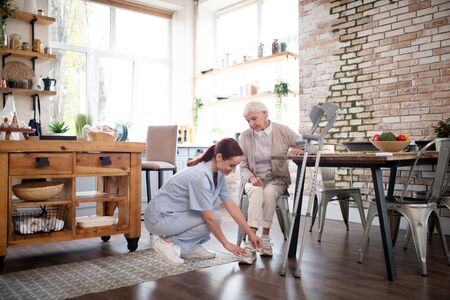Introduction to Housing Adaptations for Osteoporosis
For older adults living with osteoporosis in the UK, the home environment plays a pivotal role in maintaining both safety and independence. Osteoporosis, known for causing bone fragility, significantly increases the risk of fractures—even from minor slips or bumps. With many elderly Britons choosing to age in place, often residing in homes that were not designed with mobility or health limitations in mind, tailored housing adaptations become more than just a convenience; they are an essential aspect of daily life. The unique layout of traditional UK homes—often featuring steep stairs, narrow doorways, and limited bathroom accessibility—can pose particular challenges for those with reduced bone strength. By addressing these specific risks through targeted home modifications, we can help reduce the likelihood of injuries and support older adults in living confidently and comfortably within their own communities. In this article, we will explore why thoughtful housing adaptations are crucial for people with osteoporosis and how practical changes can make a profound difference to their quality of life.
Common Risks in British Homes for Older Adults
When considering home safety for older adults living with osteoporosis, it is vital to recognise the unique risks found in typical British homes. The traditional housing stock across the UK often features quirks that, while charming, can present real hazards. Having supported elderly relatives through their own adaptations, I’ve seen first-hand how everyday spaces can become fraught with danger when bones are fragile and mobility is reduced.
Narrow Staircases and Steep Steps
Many period properties and even some post-war houses in Britain have steep, narrow staircases. These staircases often lack sturdy handrails on both sides, making them a particular challenge. I recall visiting my grandmother’s Victorian terrace in Liverpool—her stairs were so tight that even carrying a laundry basket felt risky, let alone navigating them with weak bones. A small slip could easily result in a serious fracture for someone with osteoporosis.
Uneven Floors and Thresholds
Older British homes frequently feature uneven floors, loose carpets, and raised door thresholds. These irregularities might seem minor to most but can be treacherous trip hazards for older adults. In my own experience helping a neighbour adapt her 1930s semi-detached house in Bristol, replacing worn carpet and installing ramps at doorways made a noticeable difference to her confidence and independence.
Common Hazards Table
| Hazard | Typical Feature in UK Homes | Potential Risk for Osteoporosis |
|---|---|---|
| Narrow Staircases | Victorian/Edwardian terraces | Falls leading to fractures |
| Uneven Floors | Old floorboards, worn carpets | Trips causing bone injuries |
| Slippery Surfaces | Tiled bathrooms/kitchens | Slips resulting in broken hips or wrists |
| Poor Lighting | Dim corridors or landings | Reduced visibility increasing fall risk |
Slippery Surfaces: Kitchens and Bathrooms
Tiled flooring is common in kitchens and bathrooms but becomes especially hazardous when wet. I once slipped on a wet bathroom tile at my aunt’s flat in Manchester—thankfully without injury—but it highlighted just how easy it could be for someone with osteoporosis to suffer a life-changing fall. Simple changes like non-slip mats and grab rails can make an enormous difference.
Anecdotal Insights from Real Life
The reality is that most older adults want to remain at home as long as possible. However, adapting these quintessentially British features requires awareness and proactive planning. After seeing how quickly an innocent stumble could lead to weeks of hospitalisation for a family friend, I now believe every home should undergo a thorough safety review once osteoporosis becomes part of the picture.
![]()
3. Essential Home Safety Modifications
For older adults living with osteoporosis, the risk of falls and fractures is a daily concern—especially in the familiar but sometimes hazardous environment of home. Practical, cost-effective adaptations can make British homes much safer and more comfortable. Drawing from both practical experience and heartfelt insight, let’s look at some modifications that genuinely make a difference.
Grab Rails: Simple Yet Life-Changing
Installing sturdy grab rails in key areas such as bathrooms, by stairs, and in corridors is one of the most straightforward steps you can take. In the UK, these are widely available through local councils or occupational therapy services. Properly fitted grab rails provide crucial support when getting in and out of the bath, using the toilet, or navigating steps—helping to prevent slips without making the home feel clinical or unfriendly.
Anti-Slip Mats: Small Investment, Big Impact
Bathrooms and kitchens often have hard floors that become treacherous when wet. Anti-slip mats are an inexpensive yet effective solution. Place them inside and outside showers or baths, in front of sinks, and even by entrances where rain might be tracked in. For British homes with traditional tiled floors or laminate surfaces, these mats add an essential layer of safety for anyone with fragile bones.
Accessible Bathrooms: Comfort Meets Safety
Adapting the bathroom is a wise investment for older adults with osteoporosis. Consider walk-in showers instead of bathtubs, raised toilet seats for ease of use, and lever-style taps which are easier on arthritic hands. Many councils offer Disabled Facilities Grants to help cover costs for significant adaptations like level-access showers or widened doorways—making independent living safer and more dignified.
Additional Practical Tips
- Ensure good lighting throughout the house—install brighter bulbs or motion-sensor lights if needed.
- Declutter walkways; remove loose rugs or trailing cables that could cause trips.
- Rearrange storage so everyday items are within easy reach—no need for step-stools.
The Real Value of Home Adaptations
These changes don’t just reduce risk; they build confidence for older adults living with osteoporosis. By making thoughtful, affordable modifications suited to British homes, families can enjoy greater peace of mind—and those living with osteoporosis can maintain their independence for longer.
4. Technology and Assistive Devices in the UK
For older adults living with osteoporosis, technology and assistive devices play a pivotal role in maintaining independence and ensuring safety at home. Across the UK, a range of solutions are available through the NHS and local councils, designed to address both immediate risks (like falls) and ongoing needs for support. Here’s a closer look at how you can integrate these tools into daily life—along with some honest pros, cons, and real-world experiences from British homes.
Telecare Systems: Peace of Mind at Your Fingertips
Telecare systems use sensors and alarms to monitor for emergencies such as falls or sudden health issues. These systems can automatically alert carers or emergency services, providing reassurance for users and their families.
| Feature | Pros | Cons |
|---|---|---|
| Automatic fall detection | Immediate help dispatched; 24/7 coverage | False alarms can occur; may require regular testing |
| Remote monitoring | Loved ones can check in anytime; supports independent living | Some find it intrusive; set-up may need technical support |
| NHS/local council funding | Reduces personal cost; professional installation | Waiting lists vary by area; eligibility criteria apply |
Personal Testimony: Margaret’s Story from Kent
“After my hip fracture, my daughter insisted I get a telecare system. At first I was hesitant—it felt odd being ‘watched’. But after my first fall in the kitchen, help arrived within minutes. It’s given me back some confidence to potter about the house.”
Personal Alarms: Simple Safety Net
Wearable personal alarms—often provided free or at low cost by local councils—are an accessible solution for those worried about falling or needing urgent help. They’re especially helpful for those living alone.
| Type of Alarm | Pros | Cons |
|---|---|---|
| Pendant/wrist alarms | Easy to use; lightweight; waterproof models available for shower use | User must be able to press button; not automatic if unconscious after a fall |
| Voice-activated alarms | No need to reach device; good for limited mobility/arthritis sufferers | May not respond well to weak voices or background noise |
User Feedback: David from Manchester Shares
“I wear my alarm all day—even in the garden. It gives me and my son peace of mind that I’m never truly on my own.”
Mobility Aids: Supporting Everyday Movement
The NHS offers assessments for mobility aids ranging from walking sticks and frames to more advanced equipment like stairlifts or grab rails. Getting the right advice is crucial—contact your GP or local adult social care team for an OT (occupational therapy) assessment.
- Walking aids: Lightweight rollators or trolleys help with balance indoors and out.
- Grab rails: Strategically placed in hallways, bathrooms, and near beds/chairs.
- Stairlifts: Provided through means-tested grants (Disabled Facilities Grant) by many councils.
A Word on Independence vs. Safety: My Own Perspective as a Carer
I’ve seen first-hand how the right technology doesn’t just prevent accidents—it restores dignity. However, it’s important to balance tech reliance with active engagement in daily life; gadgets are tools, not replacements for human contact or regular exercise. Speak openly with your family and healthcare team about what feels empowering versus what feels limiting.
If you’re considering any of these adaptations, start with a local authority assessment—they’ll guide you through what’s available and suitable for your unique circumstances. The goal is always the same: making your home work for you, not against you.
5. Navigating Support and Funding
When it comes to adapting your home for osteoporosis-related needs, understanding the available support and funding in the UK can make all the difference. Many older adults feel overwhelmed at first, but there are structured pathways and resources to help ease the process. Let’s break down what you need to know and share insights from people who’ve been through this journey.
Accessing Grants for Home Adaptations
For many, the first port of call is the Disabled Facilities Grant (DFG). This government grant helps cover the cost of essential adaptations, such as installing stairlifts, ramps, or accessible bathrooms. Your local council administers these grants, and they are means-tested—so your income and savings will be taken into account. It’s worth noting that even if you think you might not qualify, applying is free and sometimes partial funding is possible.
Tip from Experience:
“Don’t hesitate to ask your council for advice early on. I almost missed out because I thought my pension would disqualify me, but they guided me through it,” shares Margaret from Manchester.
The Role of Occupational Therapy Assessments
An occupational therapy (OT) assessment is often the gateway to both financial support and practical adaptation solutions. An OT will visit your home, assess your daily routines, and recommend specific modifications that reduce fall risks and improve independence. These assessments are usually arranged through your local authority’s adult social care team. Some NHS referrals may also be possible via your GP.
Tip from Experience:
“The OT spotted things I’d never thought of—like better lighting in hallways—which really helped after a recent fracture,” says Tom from Bristol.
Local Authority Support: What to Expect
Your local authority can provide more than just funding—they offer guidance throughout the adaptation process. This might include help with paperwork, coordination with builders, or advice on reputable contractors familiar with accessible design standards in the UK.
Tip from Experience:
“Keep a diary of your communications with the council and contractors—it made everything smoother when questions cropped up,” advises Sheila from Leeds.
Final Thoughts: Taking Action
Navigating support systems can feel daunting at first, but many older adults find that asking questions and leaning on community resources leads to successful outcomes. Remember, you’re not alone—many have walked this path before you, turning their homes into safer, more comfortable spaces while living with osteoporosis.
6. Promoting Independence and Wellbeing
When we talk about housing adaptations for older adults living with osteoporosis, the conversation often centres around reducing falls and making homes safer. However, from both expert advice and lived experience, it’s clear that these modifications do much more than simply safeguard against injury—they are instrumental in promoting independence and overall wellbeing.
Beyond Safety: A Holistic Approach
Implementing thoughtful changes—such as handrails on both sides of the stairs, level access showers, and non-slip flooring—doesn’t just minimise risk; it empowers older adults to move around their homes with greater confidence. When you know your environment supports you, daily tasks feel less daunting. This sense of security directly nurtures emotional wellbeing and can stave off feelings of helplessness or isolation.
Confidence Through Control
One powerful outcome I’ve witnessed is the boost in self-assurance that comes from being able to manage at home independently. Small changes like easy-grip door handles or adjustable-height kitchen units let individuals continue preparing their own meals or tending to hobbies they love, rather than relying on others. In my experience, having a say in these adaptations also gives people a renewed sense of control over their lives—a vital ingredient for maintaining dignity as we age.
The Social Ripple Effect
Expert guidance consistently highlights how maintaining independence can positively affect mental health, reduce reliance on social care services, and keep older adults connected to their communities. When someone feels capable in their own space, they’re more likely to invite friends round or join in neighbourhood activities. Over time, this active engagement helps combat loneliness—a significant concern for many living with osteoporosis.
Ultimately, housing adaptations aren’t just about safety checklists; they are about supporting autonomy and quality of life. As I’ve seen first-hand, when older adults are equipped with an environment tailored to their needs, the benefits radiate well beyond physical safety—they foster confidence, preserve independence, and enhance everyday joy.


